Code of Conduct in Sports Organizations: Controlling Player Behavior
VerifiedAdded on 2023/01/12
|8
|2483
|52
AI Summary
This report discusses the importance of code of conduct in sports organizations and how they control player behavior. It also explores the standard player contract and the rules and regulations that players must follow. The report concludes by highlighting the rights of players and the penalties for misconduct.
Contribute Materials
Your contribution can guide someone’s learning journey. Share your
documents today.
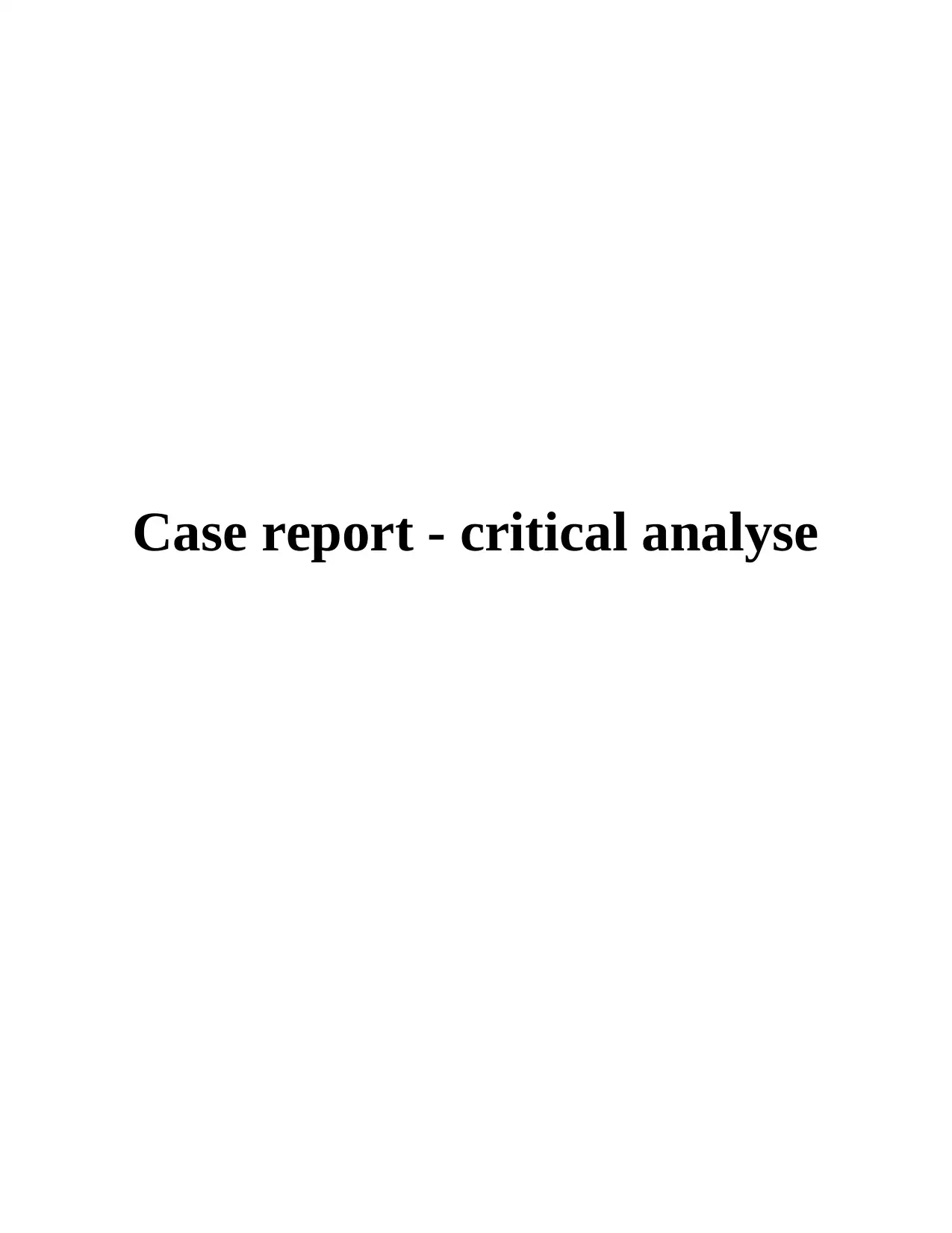
Case report - critical analyse
Secure Best Marks with AI Grader
Need help grading? Try our AI Grader for instant feedback on your assignments.
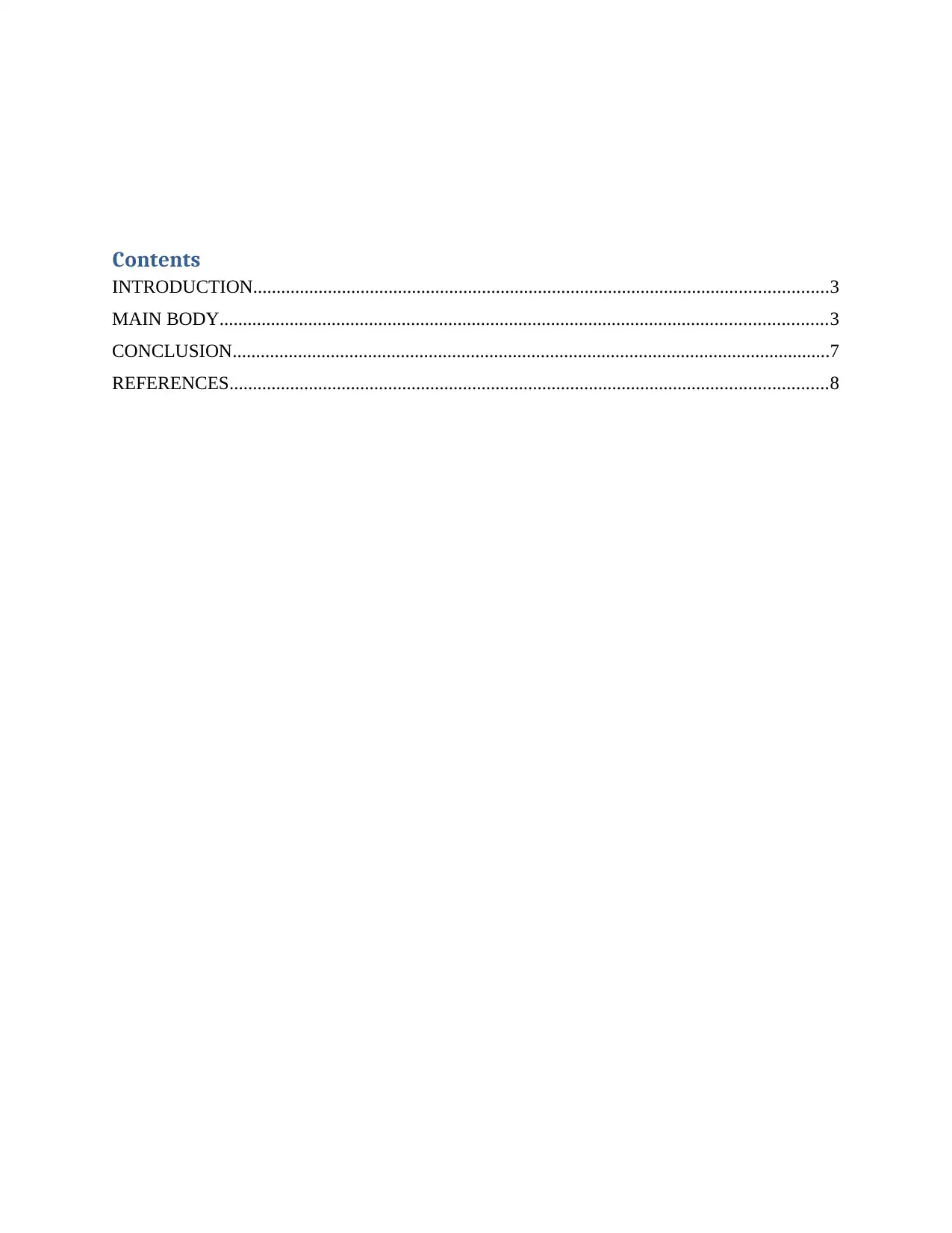
Contents
INTRODUCTION...........................................................................................................................3
MAIN BODY..................................................................................................................................3
CONCLUSION................................................................................................................................7
REFERENCES................................................................................................................................8
INTRODUCTION...........................................................................................................................3
MAIN BODY..................................................................................................................................3
CONCLUSION................................................................................................................................7
REFERENCES................................................................................................................................8
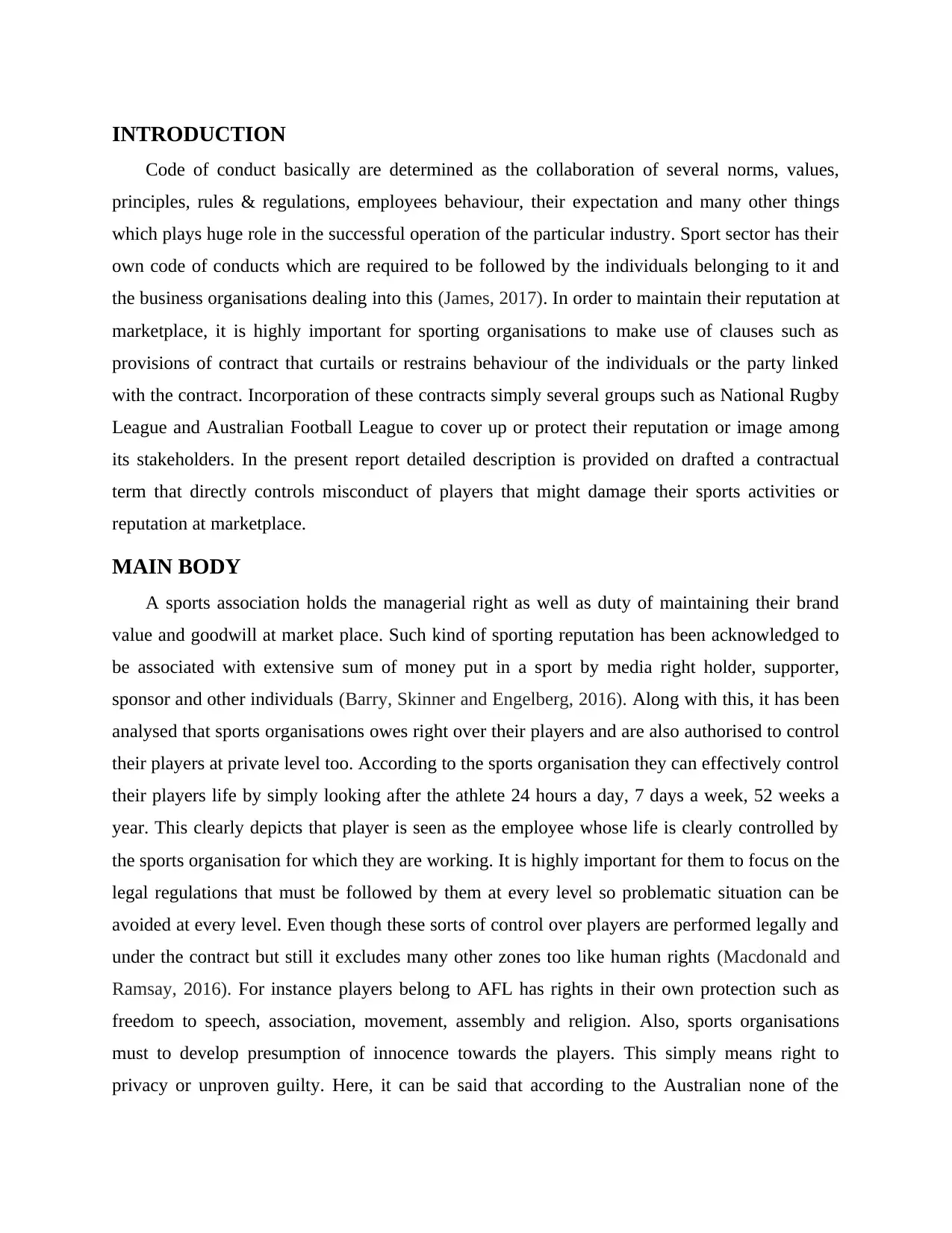
INTRODUCTION
Code of conduct basically are determined as the collaboration of several norms, values,
principles, rules & regulations, employees behaviour, their expectation and many other things
which plays huge role in the successful operation of the particular industry. Sport sector has their
own code of conducts which are required to be followed by the individuals belonging to it and
the business organisations dealing into this (James, 2017). In order to maintain their reputation at
marketplace, it is highly important for sporting organisations to make use of clauses such as
provisions of contract that curtails or restrains behaviour of the individuals or the party linked
with the contract. Incorporation of these contracts simply several groups such as National Rugby
League and Australian Football League to cover up or protect their reputation or image among
its stakeholders. In the present report detailed description is provided on drafted a contractual
term that directly controls misconduct of players that might damage their sports activities or
reputation at marketplace.
MAIN BODY
A sports association holds the managerial right as well as duty of maintaining their brand
value and goodwill at market place. Such kind of sporting reputation has been acknowledged to
be associated with extensive sum of money put in a sport by media right holder, supporter,
sponsor and other individuals (Barry, Skinner and Engelberg, 2016). Along with this, it has been
analysed that sports organisations owes right over their players and are also authorised to control
their players at private level too. According to the sports organisation they can effectively control
their players life by simply looking after the athlete 24 hours a day, 7 days a week, 52 weeks a
year. This clearly depicts that player is seen as the employee whose life is clearly controlled by
the sports organisation for which they are working. It is highly important for them to focus on the
legal regulations that must be followed by them at every level so problematic situation can be
avoided at every level. Even though these sorts of control over players are performed legally and
under the contract but still it excludes many other zones too like human rights (Macdonald and
Ramsay, 2016). For instance players belong to AFL has rights in their own protection such as
freedom to speech, association, movement, assembly and religion. Also, sports organisations
must to develop presumption of innocence towards the players. This simply means right to
privacy or unproven guilty. Here, it can be said that according to the Australian none of the
Code of conduct basically are determined as the collaboration of several norms, values,
principles, rules & regulations, employees behaviour, their expectation and many other things
which plays huge role in the successful operation of the particular industry. Sport sector has their
own code of conducts which are required to be followed by the individuals belonging to it and
the business organisations dealing into this (James, 2017). In order to maintain their reputation at
marketplace, it is highly important for sporting organisations to make use of clauses such as
provisions of contract that curtails or restrains behaviour of the individuals or the party linked
with the contract. Incorporation of these contracts simply several groups such as National Rugby
League and Australian Football League to cover up or protect their reputation or image among
its stakeholders. In the present report detailed description is provided on drafted a contractual
term that directly controls misconduct of players that might damage their sports activities or
reputation at marketplace.
MAIN BODY
A sports association holds the managerial right as well as duty of maintaining their brand
value and goodwill at market place. Such kind of sporting reputation has been acknowledged to
be associated with extensive sum of money put in a sport by media right holder, supporter,
sponsor and other individuals (Barry, Skinner and Engelberg, 2016). Along with this, it has been
analysed that sports organisations owes right over their players and are also authorised to control
their players at private level too. According to the sports organisation they can effectively control
their players life by simply looking after the athlete 24 hours a day, 7 days a week, 52 weeks a
year. This clearly depicts that player is seen as the employee whose life is clearly controlled by
the sports organisation for which they are working. It is highly important for them to focus on the
legal regulations that must be followed by them at every level so problematic situation can be
avoided at every level. Even though these sorts of control over players are performed legally and
under the contract but still it excludes many other zones too like human rights (Macdonald and
Ramsay, 2016). For instance players belong to AFL has rights in their own protection such as
freedom to speech, association, movement, assembly and religion. Also, sports organisations
must to develop presumption of innocence towards the players. This simply means right to
privacy or unproven guilty. Here, it can be said that according to the Australian none of the
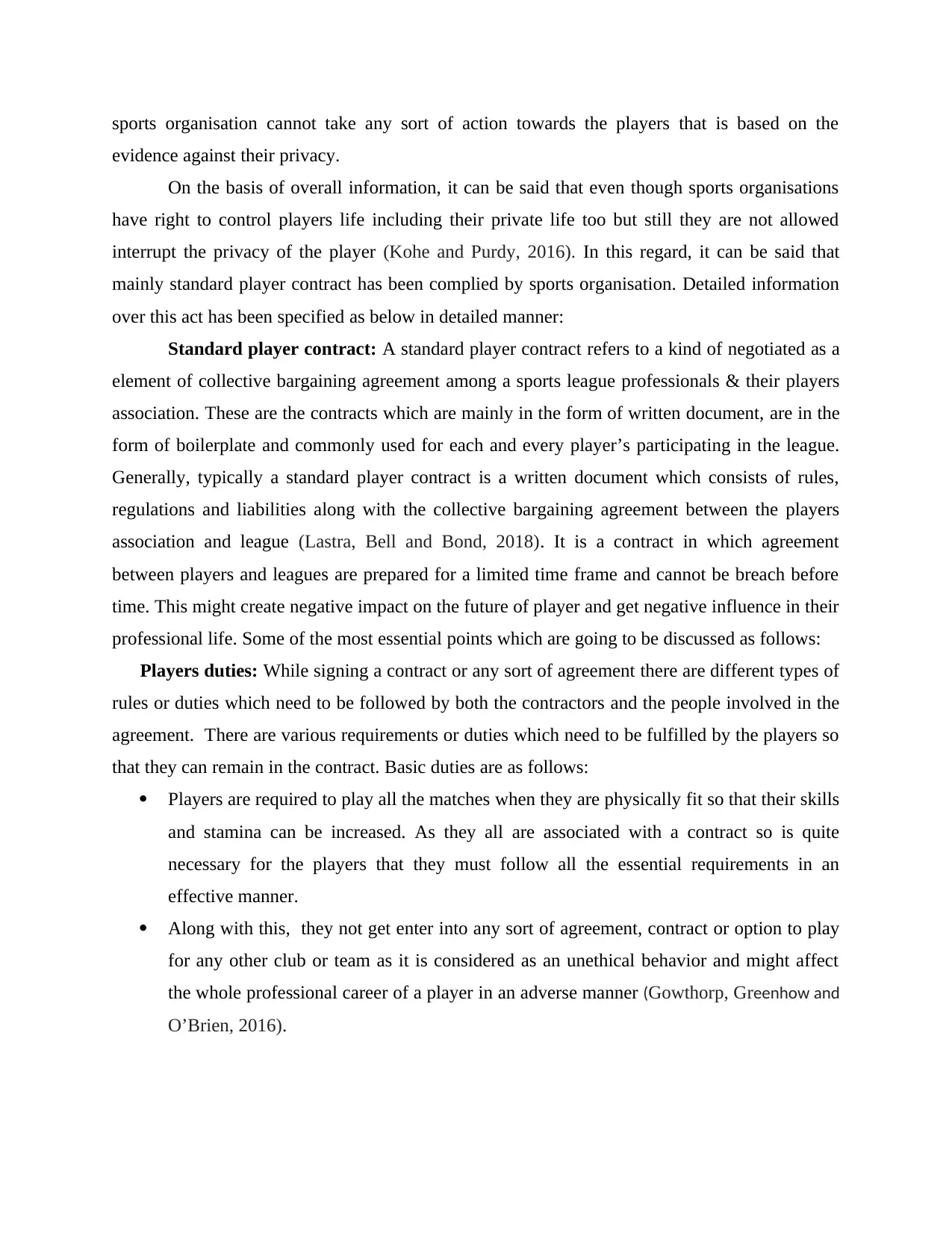
sports organisation cannot take any sort of action towards the players that is based on the
evidence against their privacy.
On the basis of overall information, it can be said that even though sports organisations
have right to control players life including their private life too but still they are not allowed
interrupt the privacy of the player (Kohe and Purdy, 2016). In this regard, it can be said that
mainly standard player contract has been complied by sports organisation. Detailed information
over this act has been specified as below in detailed manner:
Standard player contract: A standard player contract refers to a kind of negotiated as a
element of collective bargaining agreement among a sports league professionals & their players
association. These are the contracts which are mainly in the form of written document, are in the
form of boilerplate and commonly used for each and every player’s participating in the league.
Generally, typically a standard player contract is a written document which consists of rules,
regulations and liabilities along with the collective bargaining agreement between the players
association and league (Lastra, Bell and Bond, 2018). It is a contract in which agreement
between players and leagues are prepared for a limited time frame and cannot be breach before
time. This might create negative impact on the future of player and get negative influence in their
professional life. Some of the most essential points which are going to be discussed as follows:
Players duties: While signing a contract or any sort of agreement there are different types of
rules or duties which need to be followed by both the contractors and the people involved in the
agreement. There are various requirements or duties which need to be fulfilled by the players so
that they can remain in the contract. Basic duties are as follows:
Players are required to play all the matches when they are physically fit so that their skills
and stamina can be increased. As they all are associated with a contract so is quite
necessary for the players that they must follow all the essential requirements in an
effective manner.
Along with this, they not get enter into any sort of agreement, contract or option to play
for any other club or team as it is considered as an unethical behavior and might affect
the whole professional career of a player in an adverse manner (Gowthorp, Greenhow and
O’Brien, 2016).
evidence against their privacy.
On the basis of overall information, it can be said that even though sports organisations
have right to control players life including their private life too but still they are not allowed
interrupt the privacy of the player (Kohe and Purdy, 2016). In this regard, it can be said that
mainly standard player contract has been complied by sports organisation. Detailed information
over this act has been specified as below in detailed manner:
Standard player contract: A standard player contract refers to a kind of negotiated as a
element of collective bargaining agreement among a sports league professionals & their players
association. These are the contracts which are mainly in the form of written document, are in the
form of boilerplate and commonly used for each and every player’s participating in the league.
Generally, typically a standard player contract is a written document which consists of rules,
regulations and liabilities along with the collective bargaining agreement between the players
association and league (Lastra, Bell and Bond, 2018). It is a contract in which agreement
between players and leagues are prepared for a limited time frame and cannot be breach before
time. This might create negative impact on the future of player and get negative influence in their
professional life. Some of the most essential points which are going to be discussed as follows:
Players duties: While signing a contract or any sort of agreement there are different types of
rules or duties which need to be followed by both the contractors and the people involved in the
agreement. There are various requirements or duties which need to be fulfilled by the players so
that they can remain in the contract. Basic duties are as follows:
Players are required to play all the matches when they are physically fit so that their skills
and stamina can be increased. As they all are associated with a contract so is quite
necessary for the players that they must follow all the essential requirements in an
effective manner.
Along with this, they not get enter into any sort of agreement, contract or option to play
for any other club or team as it is considered as an unethical behavior and might affect
the whole professional career of a player in an adverse manner (Gowthorp, Greenhow and
O’Brien, 2016).
Secure Best Marks with AI Grader
Need help grading? Try our AI Grader for instant feedback on your assignments.
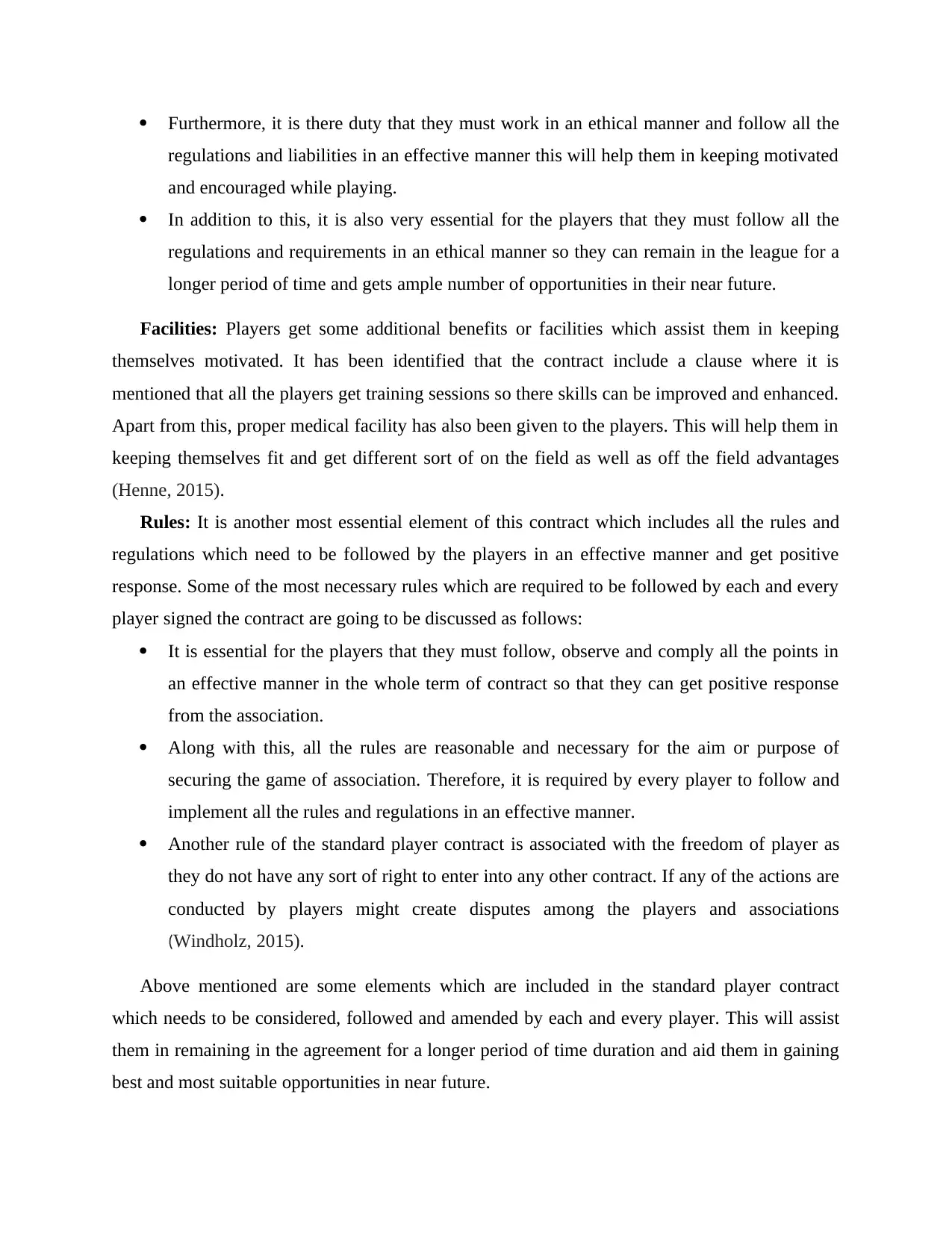
Furthermore, it is there duty that they must work in an ethical manner and follow all the
regulations and liabilities in an effective manner this will help them in keeping motivated
and encouraged while playing.
In addition to this, it is also very essential for the players that they must follow all the
regulations and requirements in an ethical manner so they can remain in the league for a
longer period of time and gets ample number of opportunities in their near future.
Facilities: Players get some additional benefits or facilities which assist them in keeping
themselves motivated. It has been identified that the contract include a clause where it is
mentioned that all the players get training sessions so there skills can be improved and enhanced.
Apart from this, proper medical facility has also been given to the players. This will help them in
keeping themselves fit and get different sort of on the field as well as off the field advantages
(Henne, 2015).
Rules: It is another most essential element of this contract which includes all the rules and
regulations which need to be followed by the players in an effective manner and get positive
response. Some of the most necessary rules which are required to be followed by each and every
player signed the contract are going to be discussed as follows:
It is essential for the players that they must follow, observe and comply all the points in
an effective manner in the whole term of contract so that they can get positive response
from the association.
Along with this, all the rules are reasonable and necessary for the aim or purpose of
securing the game of association. Therefore, it is required by every player to follow and
implement all the rules and regulations in an effective manner.
Another rule of the standard player contract is associated with the freedom of player as
they do not have any sort of right to enter into any other contract. If any of the actions are
conducted by players might create disputes among the players and associations
(Windholz, 2015).
Above mentioned are some elements which are included in the standard player contract
which needs to be considered, followed and amended by each and every player. This will assist
them in remaining in the agreement for a longer period of time duration and aid them in gaining
best and most suitable opportunities in near future.
regulations and liabilities in an effective manner this will help them in keeping motivated
and encouraged while playing.
In addition to this, it is also very essential for the players that they must follow all the
regulations and requirements in an ethical manner so they can remain in the league for a
longer period of time and gets ample number of opportunities in their near future.
Facilities: Players get some additional benefits or facilities which assist them in keeping
themselves motivated. It has been identified that the contract include a clause where it is
mentioned that all the players get training sessions so there skills can be improved and enhanced.
Apart from this, proper medical facility has also been given to the players. This will help them in
keeping themselves fit and get different sort of on the field as well as off the field advantages
(Henne, 2015).
Rules: It is another most essential element of this contract which includes all the rules and
regulations which need to be followed by the players in an effective manner and get positive
response. Some of the most necessary rules which are required to be followed by each and every
player signed the contract are going to be discussed as follows:
It is essential for the players that they must follow, observe and comply all the points in
an effective manner in the whole term of contract so that they can get positive response
from the association.
Along with this, all the rules are reasonable and necessary for the aim or purpose of
securing the game of association. Therefore, it is required by every player to follow and
implement all the rules and regulations in an effective manner.
Another rule of the standard player contract is associated with the freedom of player as
they do not have any sort of right to enter into any other contract. If any of the actions are
conducted by players might create disputes among the players and associations
(Windholz, 2015).
Above mentioned are some elements which are included in the standard player contract
which needs to be considered, followed and amended by each and every player. This will assist
them in remaining in the agreement for a longer period of time duration and aid them in gaining
best and most suitable opportunities in near future.
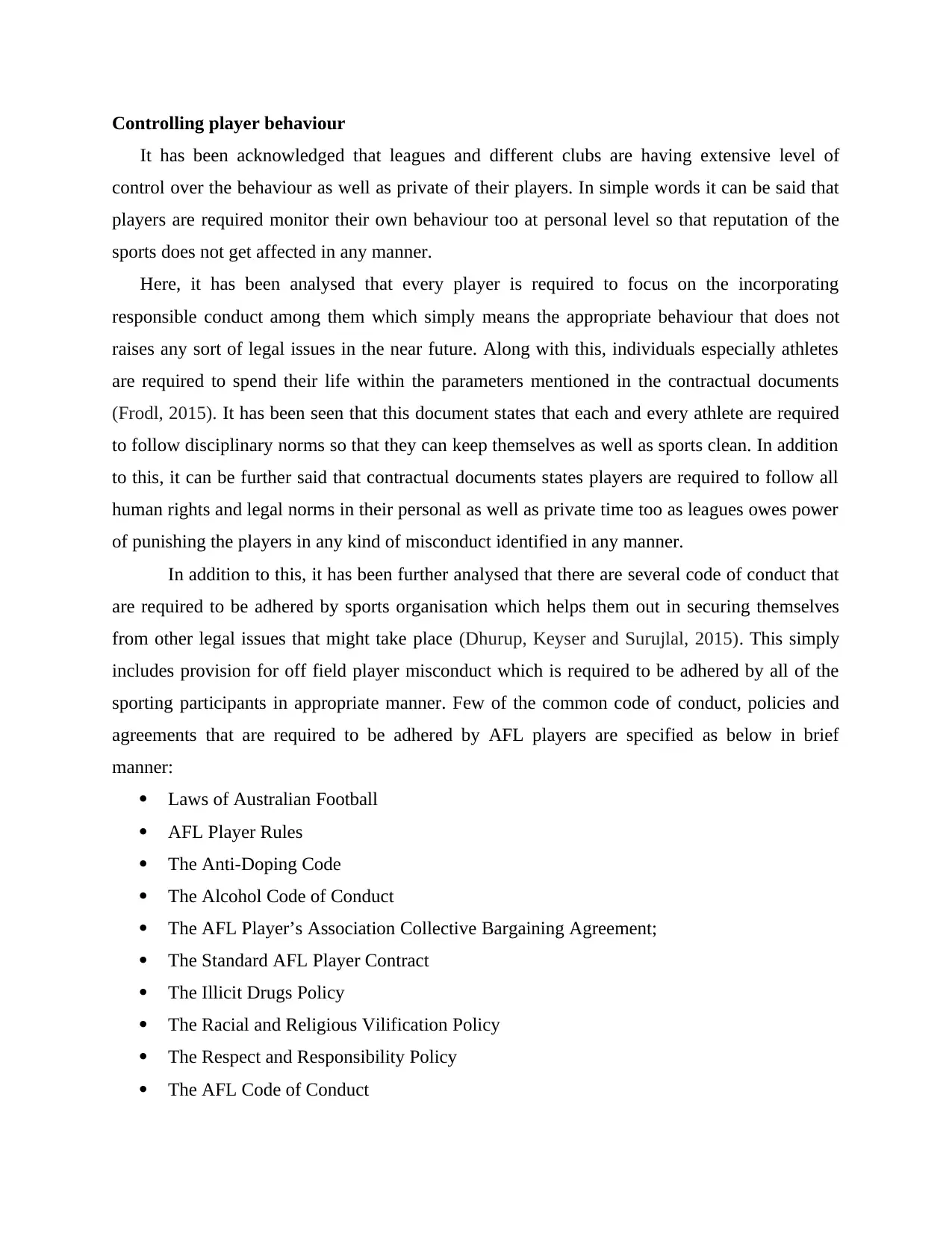
Controlling player behaviour
It has been acknowledged that leagues and different clubs are having extensive level of
control over the behaviour as well as private of their players. In simple words it can be said that
players are required monitor their own behaviour too at personal level so that reputation of the
sports does not get affected in any manner.
Here, it has been analysed that every player is required to focus on the incorporating
responsible conduct among them which simply means the appropriate behaviour that does not
raises any sort of legal issues in the near future. Along with this, individuals especially athletes
are required to spend their life within the parameters mentioned in the contractual documents
(Frodl, 2015). It has been seen that this document states that each and every athlete are required
to follow disciplinary norms so that they can keep themselves as well as sports clean. In addition
to this, it can be further said that contractual documents states players are required to follow all
human rights and legal norms in their personal as well as private time too as leagues owes power
of punishing the players in any kind of misconduct identified in any manner.
In addition to this, it has been further analysed that there are several code of conduct that
are required to be adhered by sports organisation which helps them out in securing themselves
from other legal issues that might take place (Dhurup, Keyser and Surujlal, 2015). This simply
includes provision for off field player misconduct which is required to be adhered by all of the
sporting participants in appropriate manner. Few of the common code of conduct, policies and
agreements that are required to be adhered by AFL players are specified as below in brief
manner:
Laws of Australian Football
AFL Player Rules
The Anti-Doping Code
The Alcohol Code of Conduct
The AFL Player’s Association Collective Bargaining Agreement;
The Standard AFL Player Contract
The Illicit Drugs Policy
The Racial and Religious Vilification Policy
The Respect and Responsibility Policy
The AFL Code of Conduct
It has been acknowledged that leagues and different clubs are having extensive level of
control over the behaviour as well as private of their players. In simple words it can be said that
players are required monitor their own behaviour too at personal level so that reputation of the
sports does not get affected in any manner.
Here, it has been analysed that every player is required to focus on the incorporating
responsible conduct among them which simply means the appropriate behaviour that does not
raises any sort of legal issues in the near future. Along with this, individuals especially athletes
are required to spend their life within the parameters mentioned in the contractual documents
(Frodl, 2015). It has been seen that this document states that each and every athlete are required
to follow disciplinary norms so that they can keep themselves as well as sports clean. In addition
to this, it can be further said that contractual documents states players are required to follow all
human rights and legal norms in their personal as well as private time too as leagues owes power
of punishing the players in any kind of misconduct identified in any manner.
In addition to this, it has been further analysed that there are several code of conduct that
are required to be adhered by sports organisation which helps them out in securing themselves
from other legal issues that might take place (Dhurup, Keyser and Surujlal, 2015). This simply
includes provision for off field player misconduct which is required to be adhered by all of the
sporting participants in appropriate manner. Few of the common code of conduct, policies and
agreements that are required to be adhered by AFL players are specified as below in brief
manner:
Laws of Australian Football
AFL Player Rules
The Anti-Doping Code
The Alcohol Code of Conduct
The AFL Player’s Association Collective Bargaining Agreement;
The Standard AFL Player Contract
The Illicit Drugs Policy
The Racial and Religious Vilification Policy
The Respect and Responsibility Policy
The AFL Code of Conduct
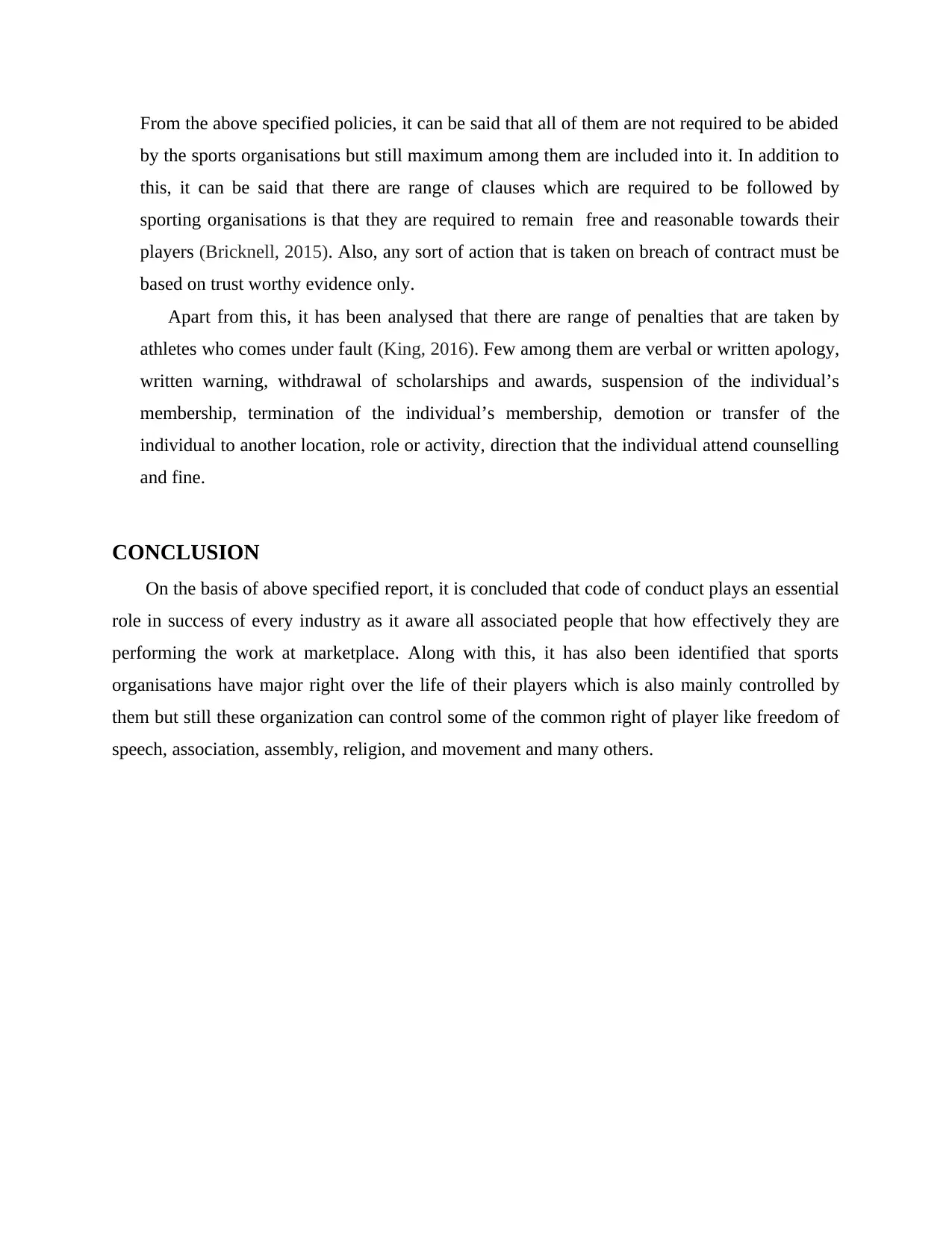
From the above specified policies, it can be said that all of them are not required to be abided
by the sports organisations but still maximum among them are included into it. In addition to
this, it can be said that there are range of clauses which are required to be followed by
sporting organisations is that they are required to remain free and reasonable towards their
players (Bricknell, 2015). Also, any sort of action that is taken on breach of contract must be
based on trust worthy evidence only.
Apart from this, it has been analysed that there are range of penalties that are taken by
athletes who comes under fault (King, 2016). Few among them are verbal or written apology,
written warning, withdrawal of scholarships and awards, suspension of the individual’s
membership, termination of the individual’s membership, demotion or transfer of the
individual to another location, role or activity, direction that the individual attend counselling
and fine.
CONCLUSION
On the basis of above specified report, it is concluded that code of conduct plays an essential
role in success of every industry as it aware all associated people that how effectively they are
performing the work at marketplace. Along with this, it has also been identified that sports
organisations have major right over the life of their players which is also mainly controlled by
them but still these organization can control some of the common right of player like freedom of
speech, association, assembly, religion, and movement and many others.
by the sports organisations but still maximum among them are included into it. In addition to
this, it can be said that there are range of clauses which are required to be followed by
sporting organisations is that they are required to remain free and reasonable towards their
players (Bricknell, 2015). Also, any sort of action that is taken on breach of contract must be
based on trust worthy evidence only.
Apart from this, it has been analysed that there are range of penalties that are taken by
athletes who comes under fault (King, 2016). Few among them are verbal or written apology,
written warning, withdrawal of scholarships and awards, suspension of the individual’s
membership, termination of the individual’s membership, demotion or transfer of the
individual to another location, role or activity, direction that the individual attend counselling
and fine.
CONCLUSION
On the basis of above specified report, it is concluded that code of conduct plays an essential
role in success of every industry as it aware all associated people that how effectively they are
performing the work at marketplace. Along with this, it has also been identified that sports
organisations have major right over the life of their players which is also mainly controlled by
them but still these organization can control some of the common right of player like freedom of
speech, association, assembly, religion, and movement and many others.
Paraphrase This Document
Need a fresh take? Get an instant paraphrase of this document with our AI Paraphraser
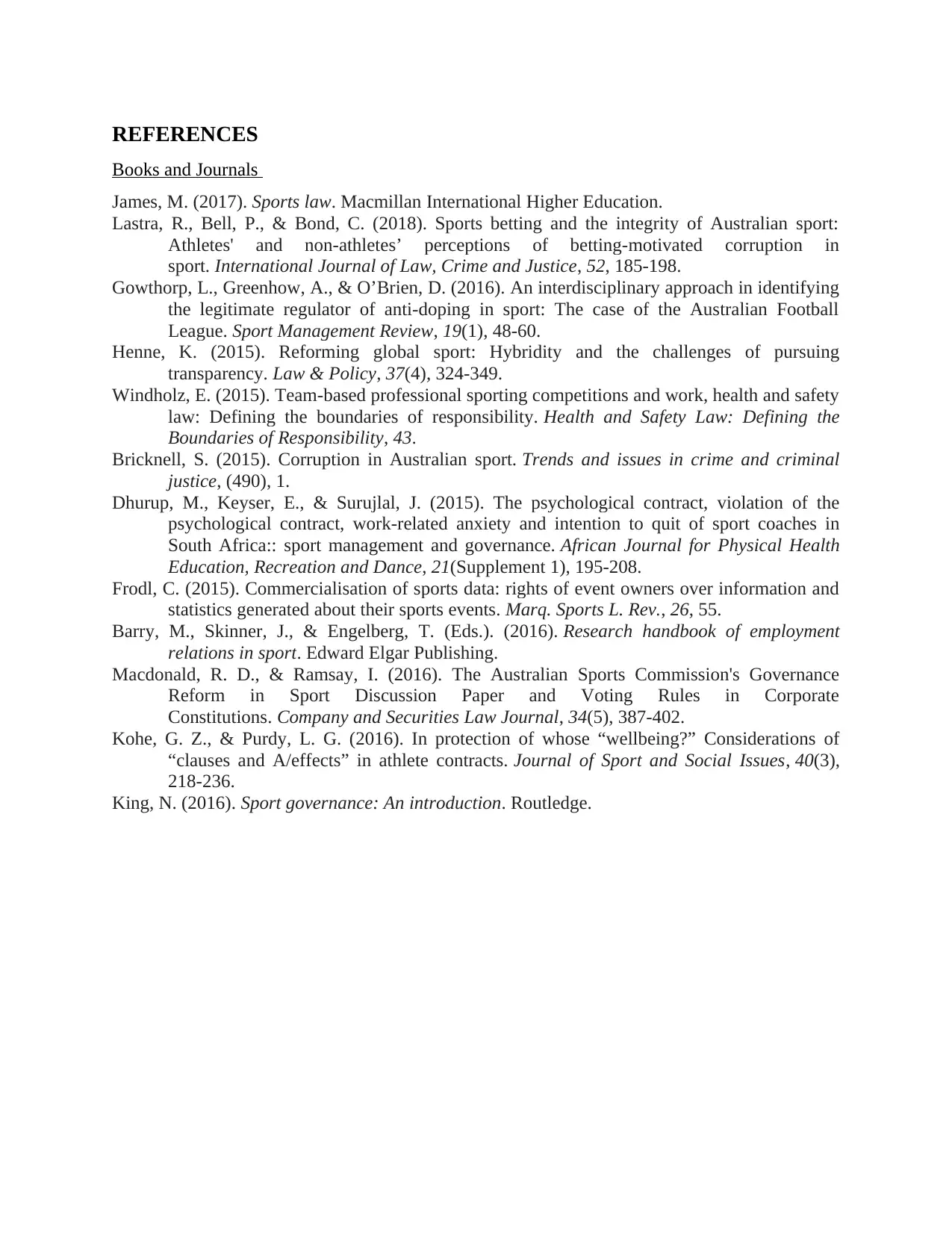
REFERENCES
Books and Journals
James, M. (2017). Sports law. Macmillan International Higher Education.
Lastra, R., Bell, P., & Bond, C. (2018). Sports betting and the integrity of Australian sport:
Athletes' and non-athletes’ perceptions of betting-motivated corruption in
sport. International Journal of Law, Crime and Justice, 52, 185-198.
Gowthorp, L., Greenhow, A., & O’Brien, D. (2016). An interdisciplinary approach in identifying
the legitimate regulator of anti-doping in sport: The case of the Australian Football
League. Sport Management Review, 19(1), 48-60.
Henne, K. (2015). Reforming global sport: Hybridity and the challenges of pursuing
transparency. Law & Policy, 37(4), 324-349.
Windholz, E. (2015). Team-based professional sporting competitions and work, health and safety
law: Defining the boundaries of responsibility. Health and Safety Law: Defining the
Boundaries of Responsibility, 43.
Bricknell, S. (2015). Corruption in Australian sport. Trends and issues in crime and criminal
justice, (490), 1.
Dhurup, M., Keyser, E., & Surujlal, J. (2015). The psychological contract, violation of the
psychological contract, work-related anxiety and intention to quit of sport coaches in
South Africa:: sport management and governance. African Journal for Physical Health
Education, Recreation and Dance, 21(Supplement 1), 195-208.
Frodl, C. (2015). Commercialisation of sports data: rights of event owners over information and
statistics generated about their sports events. Marq. Sports L. Rev., 26, 55.
Barry, M., Skinner, J., & Engelberg, T. (Eds.). (2016). Research handbook of employment
relations in sport. Edward Elgar Publishing.
Macdonald, R. D., & Ramsay, I. (2016). The Australian Sports Commission's Governance
Reform in Sport Discussion Paper and Voting Rules in Corporate
Constitutions. Company and Securities Law Journal, 34(5), 387-402.
Kohe, G. Z., & Purdy, L. G. (2016). In protection of whose “wellbeing?” Considerations of
“clauses and A/effects” in athlete contracts. Journal of Sport and Social Issues, 40(3),
218-236.
King, N. (2016). Sport governance: An introduction. Routledge.
Books and Journals
James, M. (2017). Sports law. Macmillan International Higher Education.
Lastra, R., Bell, P., & Bond, C. (2018). Sports betting and the integrity of Australian sport:
Athletes' and non-athletes’ perceptions of betting-motivated corruption in
sport. International Journal of Law, Crime and Justice, 52, 185-198.
Gowthorp, L., Greenhow, A., & O’Brien, D. (2016). An interdisciplinary approach in identifying
the legitimate regulator of anti-doping in sport: The case of the Australian Football
League. Sport Management Review, 19(1), 48-60.
Henne, K. (2015). Reforming global sport: Hybridity and the challenges of pursuing
transparency. Law & Policy, 37(4), 324-349.
Windholz, E. (2015). Team-based professional sporting competitions and work, health and safety
law: Defining the boundaries of responsibility. Health and Safety Law: Defining the
Boundaries of Responsibility, 43.
Bricknell, S. (2015). Corruption in Australian sport. Trends and issues in crime and criminal
justice, (490), 1.
Dhurup, M., Keyser, E., & Surujlal, J. (2015). The psychological contract, violation of the
psychological contract, work-related anxiety and intention to quit of sport coaches in
South Africa:: sport management and governance. African Journal for Physical Health
Education, Recreation and Dance, 21(Supplement 1), 195-208.
Frodl, C. (2015). Commercialisation of sports data: rights of event owners over information and
statistics generated about their sports events. Marq. Sports L. Rev., 26, 55.
Barry, M., Skinner, J., & Engelberg, T. (Eds.). (2016). Research handbook of employment
relations in sport. Edward Elgar Publishing.
Macdonald, R. D., & Ramsay, I. (2016). The Australian Sports Commission's Governance
Reform in Sport Discussion Paper and Voting Rules in Corporate
Constitutions. Company and Securities Law Journal, 34(5), 387-402.
Kohe, G. Z., & Purdy, L. G. (2016). In protection of whose “wellbeing?” Considerations of
“clauses and A/effects” in athlete contracts. Journal of Sport and Social Issues, 40(3),
218-236.
King, N. (2016). Sport governance: An introduction. Routledge.
1 out of 8
Your All-in-One AI-Powered Toolkit for Academic Success.
+13062052269
info@desklib.com
Available 24*7 on WhatsApp / Email
![[object Object]](/_next/static/media/star-bottom.7253800d.svg)
Unlock your academic potential
© 2024 | Zucol Services PVT LTD | All rights reserved.